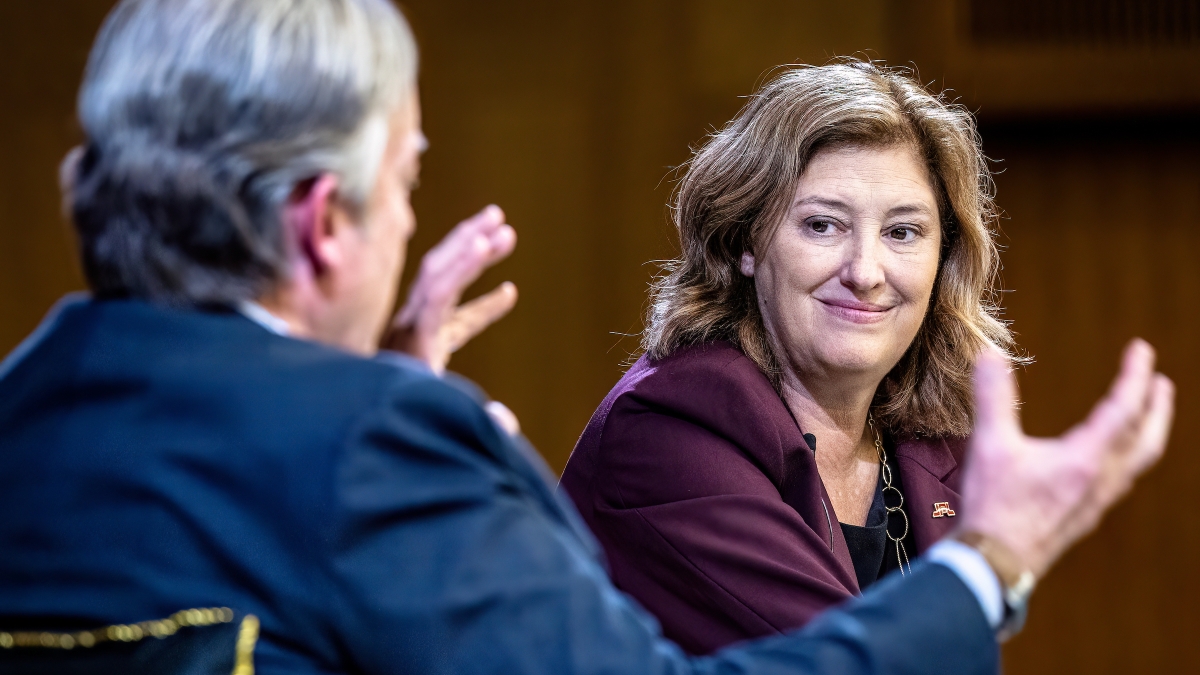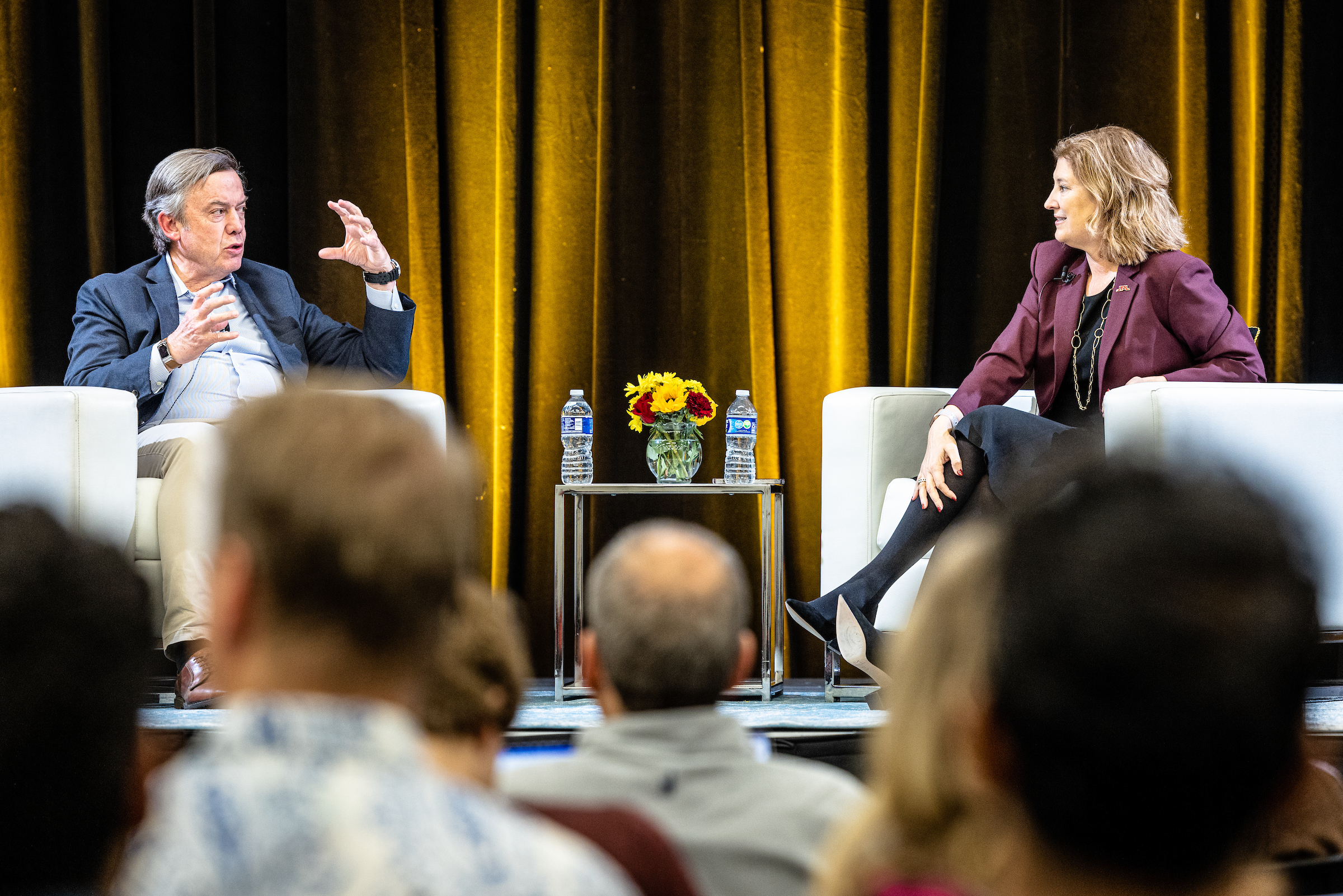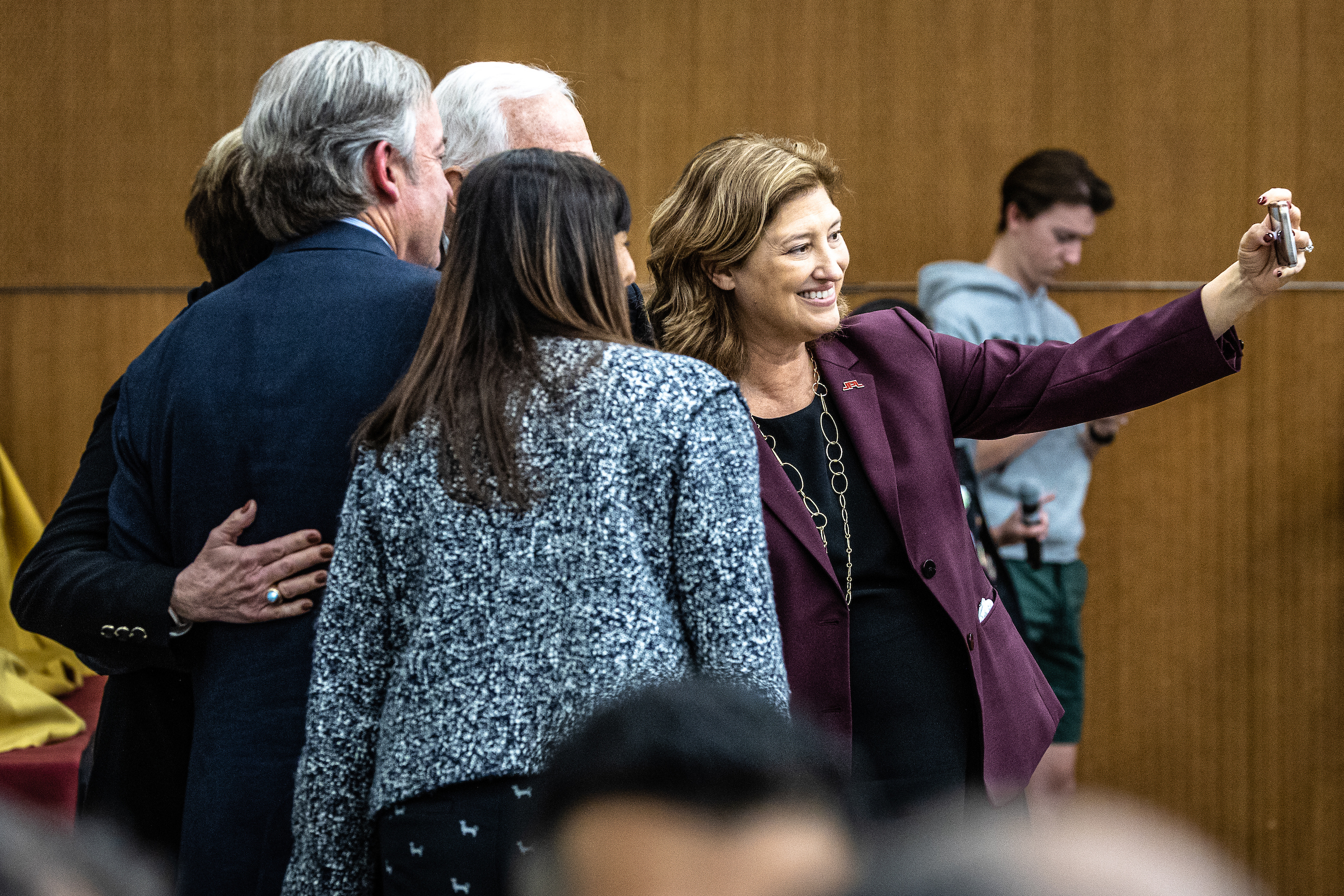Laurie Leshin can remember the precise moment she became interested in space.
It was 1976 and the Viking 1 Lander had touched down on the surface of Mars. Ten years old, Leshin stood in her mother’s kitchen and was transfixed by the images.
“I wanted to reach out and touch those rocks,” she recalled. “The landscape of Mars kind of spoke to me as an Arizona girl.”
Leshin is still an Arizona girl – she’s an alum and former professor at Arizona State University – and she’s still fascinated by space.
Only now, she’s leading missions into it.
Leshin, a professor in geological sciences from 1998 to 2005, is the director of NASA’s Jet Propulsion Laboratory in Pasadena, California. She is receiving a 2023 Alumni Achievement Award as part of ASU’s Founders' Day, and on Wednesday she sat down for a one-hour conversation with ASU President Michael Crow about current and future space exploration.
NASA JPL Director Laurie Leshin talks with ASU President Michael Crow on Wednesday, March 1, at the Student Pavilion on the Tempe campus. Leshin is an ASU alumna, a former professor of geological sciences at ASU and served as a director of its Center for Meteorite Studies. Photo by Charlie Leight/ASU News
Leshin said her desire to “have a job in the space business” started to become reality when she attended ASU. As a freshman, she was standing outside the chemistry office one day when she saw an advertisement for a summer internship at NASA.
She knocked on the office door of Professor Susan Wyckoff, who was an astronomer, and said, "You don’t know me, but I’m really interested in this internship and can you help me?"
“I’ll never forget,” Leshin said. “I can still see the picture of her dropping what she was working on and saying, ‘Come on in.’ A half hour later, she was on the phone to the people running the internship saying, ‘I have this fabulous student sitting here.’ Long story short, I got the summer internship at NASA and that was really the thing that changed my life.”
Leshin said she’s fascinated by the ebb and flow of science questions since the mid-1970s, when Viking 1 landed.
“It was trying to figure out whether there was life on Mars,” she said. “The way it approached its experiments, we realize now, we were asking that question in a not very smart way. And people were kind of embarrassed by that until we actually didn’t ask that question for a long time because it was sort of like, ‘Oh, is that real science?’
“Well, guess what? The pendulum has swung completely back. And now we sit on the precipice of actually being able to answer the question, 'Are we alone in the universe? Have we always been alone in the universe?' To me, it’s the biggest question that a scientist can ask. And in the next 20 years, I believe we have the best shot in history of answering it.”
Leshin said NASA has approximately 40 missions currently flying, another 15 in development and then another 15 to 20 that are on the docket.
“Why so many missions?” Crow asked.
“There’s a lot to do,” Leshin said with a wide smile.
NASA JPL Director Laurie Leshin (right) snaps a selfie with philanthropists Barbara and Craig Barrett, ASU President Michael Crow and ASU Professor Meenakshi Wadhwa before taking the stage for a fireside chat with Crow on Wednesday, March 1, at the Student Pavilion on the Tempe campus. Photo by Charlie Leight/ASU News
One of those missions Leshin spoke enthusiastically about, the Mars Sample Return Program, has direct ties to ASU. Meenakshi Wadhwa, the school director and Foundation Professor in the School of Earth and Space Exploration, is the principal scientist for the program, which will attempt later this decade to bring samples back from Mars via a rocket that launches off the planet’s surface.
“We’ve never done that before, send the sample up into orbit inside this little container that sort of looks like, I don’t know, a volleyball or rugby ball,” Leshin said. “So, this is a really big deal. One, just demonstrating the fact we’re doing the round trip. Two, we really would like to know in much more detail about what the environment is like based on the dirt surface of Mars. And we’ll learn that from bringing it back.”
Leshin said the Mars Sample Return Program is one of the most complicated science missions NASA has undertaken.
“It’s going to be extraordinarily challenging and extraordinarily exciting, but the science is worth it because this I think is the best near-term chance we have to answer that question (about life on Mars).”
Near the end of their conversation, Crow asked Leshin what advice she would give to ASU’s students.
“Be a constant learner,” Leshin said. “Not just a lifelong learner but a constant learner every day. It’s about what am I learning today that I didn’t know yesterday. … Have a set of experiences that are impactful. Do the things that give you those kind of experiences and learn from them, reflect on them. Don’t just run on to the next thing as fast as possible. Take some time to really think about, ‘What did I learn here? Where am I going next?’
“But don’t have a perfect plan. There’s no such thing.”
Top photo: NASA JPL Director Laurie Leshin talks with ASU President Michael Crow about the university’s involvement in many NASA missions during a fireside chat at the Student Pavilion on the Tempe campus on March 1. Photo by Charlie Leight/ASU News
More Science and technology

ASU professor wins NIH Director’s New Innovator Award for research linking gene function to brain structure
Life experiences alter us in many ways, including how we act and our mental and physical health. What we go through can even change how our genes work, how the instructions coded into our DNA are…

ASU postdoctoral researcher leads initiative to support graduate student mental health
Olivia Davis had firsthand experience with anxiety and OCD before she entered grad school. Then, during the pandemic and as a result of the growing pressures of the graduate school environment, she…

ASU graduate student researching interplay between family dynamics, ADHD
The symptoms of attention deficit hyperactivity disorder (ADHD) — which include daydreaming, making careless mistakes or taking risks, having a hard time resisting temptation, difficulty getting…


